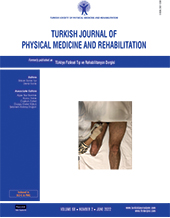The effect of activation of thoracolumbar fascia on the thickness of abdominal muscles: An ultrasonographic study
Patients and methods: Between March 1st, 2019 and March 29th, 2019, a total of 30 healthy individuals (15 males, 15 females; mean age: 28.8±8.1 years; range, 21 to 52 years) among hospital staff were included. Thickness of transversus abdominis, internal, and external oblique muscles of the participants were evaluated using ultrasound during four positions (rest, abdominal hollowing, bridge, and bridge with arm extension).
Results: The mean body mass index was 23.8±4.1 kg/m2. The thickness of transversus abdominis and internal oblique muscles increased during all positions (p<0.001), compared to rest. The thickness during bridge with arm extension was greater than abdominal hollowing and bridge.
Conclusion: Co-activation of latissimus dorsi and gluteus maximus muscles during abdominal contraction increases the thickness of internal oblique and transversus abdominis muscles greater than abdominal contraction alone or co-activation of gluteus maximus alone. Simultaneous isometric contraction of latissimus dorsi muscle may enhance abdominal muscle function.
Keywords : Abdominal muscles, exercise, fascia, ultrasonography

















